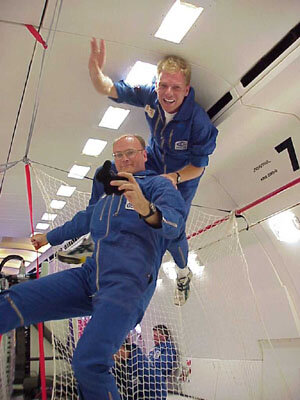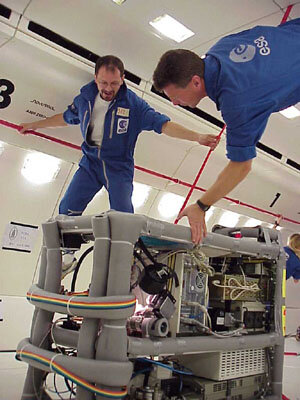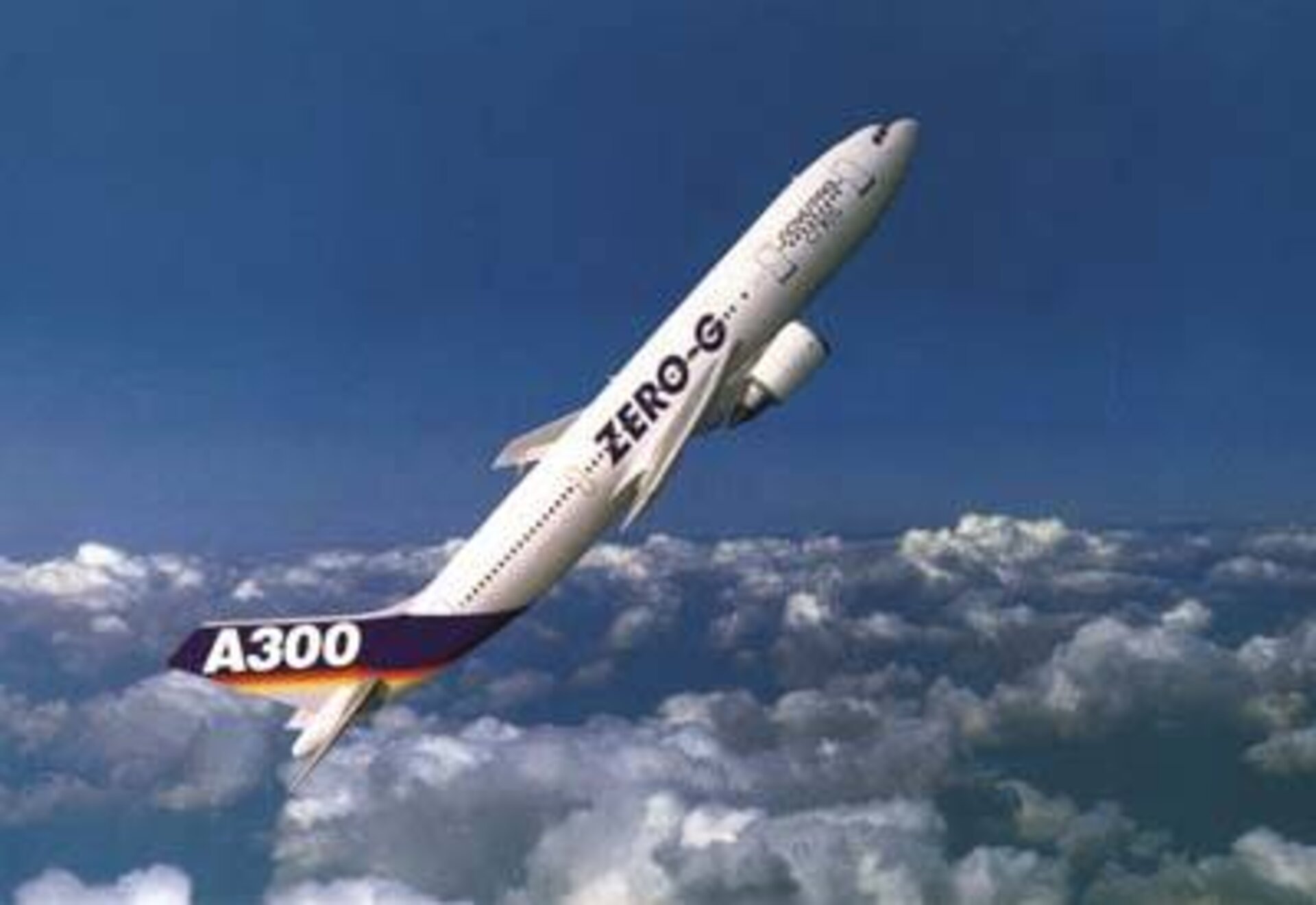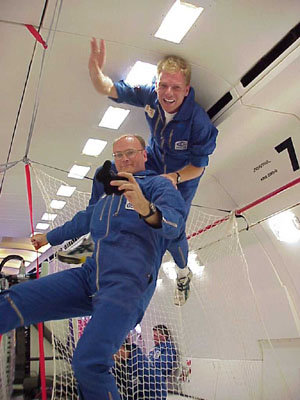The busiest ever ESA parabolic flight campaign ready to take off
The 30th ESA parabolic flight campaign is ready to start from the Bordeaux-Mérignac airport on the special Airbus A300 Zero-g. Three flights of 30 parabolas each are foreseen on the mornings of the 15, 16 and 17 May.
ESA organises this campaign to conduct research experiments in almost complete absence of gravity (microgravity) to prepare future experiments for the International Space Station. This 30th campaign since 1984 is the largest ESA campaign ever in terms of number of experiments: fourteen experiments including eight in Physical Sciences, three in Life Sciences, and three experiments proposed by students.

During a parabolic flight the aircraft performs a nose-up manoeuvre to put it into a steep climb. This creates an acceleration of 1.8 g (1.8 times the acceleration due to gravity on the ground) for about 20 seconds. Then the pilot reduces engine thrust to almost zero, injecting the aircraft into a parabola. The plane continues to climb till it reaches the apex of the parabola, then it starts descending. This condition lasts for about 25 seconds, during which the passengers and all unstrapped equipment in the cabin float in the weightlessness resulting from the free fall of the aircraft. When the angle below the horizontal reaches 45°, the pilot accelerates again and pulls up the aircraft to come back to a steady horizontal flight. These manoeuvres are usually repeated 30 times per flight.
During the weigthlessness periods, the scientist on board the aircraft can conduct their experiments. With Europe and its international partners building the International Space Station, where research will be carried on for the next 15 years, parabolic flights are crucial to the preparation of experiments, equipment and astronauts and allow scientists to have their experiments tested before they are actually flown on a space mission.

ESA runs two parabolic campaigns a year. Scientists are regularly invited to submit experiment proposals for review and selection by peers. Those whose experiments are selected have the possibility to participate in an ESA parabolic flight campaign. In each campaign ESA also includes experiments proposed by students to encourage the scientists of tomorrow to learn all about experimention in weightlessness and the extensive research opportunities the International Space Station is going to offer.
The next ESA parabolic flight campaign (the 31st) is scheduled for October 2001. This campaign will have a mixed complement of experiments in Life and Physical Sciences, with again student proposed experiments.
Further information on ESA parabolic flights can be found at ESA's special parabolic flight internet pages at : http://www.estec.esa.int/spaceflight/parabolic
You may also contact:
Vladimir Pletser
ESA/ESTEC, Microgravity Payloads Division
Directorate of Manned Spaceflight and Microgravity
Tel: + 31 71 565 33 16
Fax: +31 71 565 3141
Experiments and scientists involved in the 30th ESA parabolic flight campaign
Physical sciences:
1. "Capillary driven filtration experiments" by Prof. J.C. Legros and Drs Smirnov, Entov and Istasse (University of Brussels, B). This experiment investigates methods of filtration of liquid in porous media by capillarity and vibration to contribute to the understanding of enhancement of liquid recovery by the capillarity method, with applications in crude oil recovery in natural reservoirs.
2. "Wetting and coalescence prevention by Marangoni effect" by Prof. R. Monti, Drs R. Savino, F. Nota, S. Fico (University of Napoli, I) and Drs. R. Fortezza and D. Castagnolo (Mars Center,Napoli, I). This experiment studies the wetting prevention of a drop when squeezed against a solid wall. Studies of drop wetting are important in many technical applications, such as soldering and brazing (where the solder drop has to have a good wetting to form a solder joint), diesel engine combustion (where fuel drops arrive in cylinder walls before ignition), and during solidification processes (where liquid inclusions arrive at a solidification front at temperature lower than the surrounding melt).
3. "Annular flow film thickness and pressure drop measurements in microgravity" by Prof. K. Rezkallah (University of Saskatchewan, Canada) and Dr C. Colin (Institute of Fluid Mechanics, Toulouse, F). The experiment investigates the characteristics of liquid films of annular flow in pipes. In annular flow, the liquid is forced to the tube wall while the gas flows in the centre. It is an important flow regime in many sectors, including nuclear, oil and gas industries, refueling space vehicles and heating and refrigeration systems.
4. "Investigations on soot concentration and primary particle sizes under microgravity by advanced laser-induced incandescence techniques" by Prof. A. Leipertz, Prof. S. Will and Mr S. Dankers (University of Erlangen-Nürnberg, D) aims at improving our understanding of soot nucleation, growth and oxidation. Soot produced during combustion is a sign of energy losses due to non-optimized combustion parameters. In addition, soot particles are pollutants and understanding their formation would improve emission from technical combustors such as diesel engines or direct injection gasoline engines.
5. "Vibrational phenomena in inhomogeneous media" by Dr P. Evesque (CNRS, Ecole Centrale, Paris, F), Dr D. Beysens (CEA, Grenoble, F) and Dr Y. Garrabos (CNRS, Pessac, F) investigates the effect of vibrations in weightlessness on the inhomogeneities in two-phase fluids and granular matter. Although the effect of vibrations on stratified inhomogeneous systems has long been studied, little is known about their behaviour under vibrations when the stabilizing effect of gravity is absent. This is one of the recommended experiments that may fly in the Fluid Science Laboratory presently in development for the Columbus Laboratory.
6. "Metallic foam experiments" by Dr S. Odenbach (ZARM, University of Bremen, D) is dedicated to study the bubble and foam formation in metallic foams. Metallic foams are obtained by melting a mixture of metallic powder and a fuel having an ignition temperature lower than the powder melting temperature. When the temperature is increased, the fuel will produce gas bubbles that will mix with the metallic melt. Upon cooling, a metallic foam is obtained with the advantage of being lighter than conventional alloys. Metallic foams can have application in various domains on Earth, like structures, construction, car industries, etc. To guarantee reproducibility of metallic foams, the formation process needs to be investigated in more details to understand the intermingled role played by surface tension forces and gravity.
7. “Heat exchanger water removal for fin heat exchangers of the Refrigerator Freezer Rack (RFR)”. This experiment is proposed by a team of engineers of Astrium (D) involved in the design and development of the RFR’s to be flown on the International Space Station. The RFR is a specially designed refrigerator/freezer that will be used by astronauts on the Station for food stowage and transportation. To avoid frost on the fins, a system – to be tested on this parabolic flight campaign- has been designed to eliminate water by capillarity.
8. “Aggregation of dust accelerated by magnetic forces” by Drs H. Nübold and K.H. Glassmeier (University of Braunschweig, D) and Dr T. Poppe (University of Jena, D) investigates the effect of magnetic forces in the process of aggregation of dust particles, an important step in the formation of planets in our Solar System. In this experiment, magnetized and non-magnetized dust is injected in turn in an aggregation vacuum chamber by pyrotechnical and mechanical devices. The dust aggregates are imaged by in-situ microscopy and collected for later analysis.
Experiments proposed by students
1. “Dust aggregation” proposed by Mr M. Rost and the student Hotzenplotz team (University of Braunschweig, D) is also studying dust aggregation and is conducted in conjunction with Dr H. Nübold’s experiment above.
2. “Dendritic growth in Aluminum alloy welding” proposed by Mr S. Ferretti and the student Unibo team (University of Bologna, I) investigates the welding process of Aluminum. Aluminum alloys are generally difficult to weld on earth, requiring special procedures. This experiment can give information on the welding process in general and may lead to improved welding procedures on earth but also to develop an efficient welding technology in space, e.g. for assembling or repairing elements of the International Space Station.
3. “Orbital liquid experiment” proposed by Messrs J.M. Lopez Urdiales, F. Mancebo Ordonez, D. Meizoso Latova and P. Valls Moldenhauer (University of Madrid, SP) researches the impact of liquid drops against an almost flat liquid surface in partial gravity conditions, achieved by accelerating an experimental platform in 0 g during parabolas in the Airbus. The behaviour of a droplet impinging on the surface of the same liquid is recorded with a high speed camera, in order to characterize the impact phenomenon in function of gravity levels.
Experiments in the Life Science field (human physiology)
1. "Validation of a bone model for the monitoring of the mechanical environment of fractures in microgravity" by Prof. M. Hinsenkamp and Prof. F. Burny (University of Brussels, B). This experiment measures mechanical constraints in newly formed bone tissues. During this experiment, a model bone is subjected to several mechanical movements and the bone reaction is measured to validate the mathematical model. These measurements are a prerequisite to establish prevention programme of the bone demineralization during space flights but also in disuse osteoporosis, a condition affecting most elderly people on earth, where the bone fragilize due to loss of its minerals, mainly Calcium, and often lead to fracture.
2. "Effect of the Lower Body Negative Pressure on the cardiac electrical activity and the hemodynamical parameters" by Prof. P. Vaïda (University of Bordeaux 2, F) studies the changes in the cardiac activity due to the redistribution of body fluids in microgravity. In normal gravity, body fluids, blood mainly, are pulled downward by the force of gravity and are nominally pulled upward by the cardiovascular system. In 0 g, body fluids are no longer pulled downward and tend to overfill the vascular system of the body upper part. By applying a small negative pressure around the legs during 0g, the body fluids are pulled again toward the body lower part and specific parameters of the cardiovascular system can be studied. This is done in a LBNP caisson, a sort of cylinder in which a human subject is standing with a rubber sealing around the waist. This experiment should shed light on the orthostatic intolerance, i.e. the tendency to faint when standing up on earth in astronauts after a long space flight or in patients on ground suffering from hypotension.
3. "Does weightlessness induce peripheral vasodilatation?" of Dr P. Norsk (DAMEC, Copenhagen, DK) proposes to test the hypothesis of the dilatation of the heart and the peripheral vascular system that could be caused by weightlessness. According to this hypothesis, the organism may have a mechanism that protects the heart and the brain in microgravity from an increase of arterial pressure by dilating the vascular system to cope with the body fluid shift from the lower to the upper part of the body in 0 g. During the experiment, the maintenance of arterial pressure is investigated in several human subjects. Several physiological parameters are measured, including the cardiac output by the non-invasive rebreathing method.





